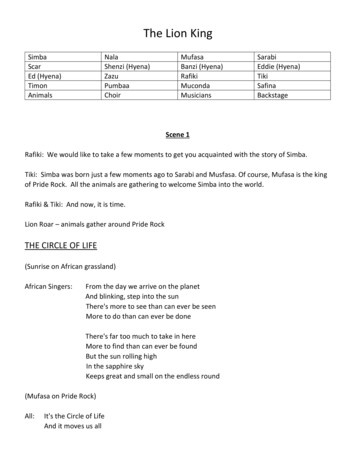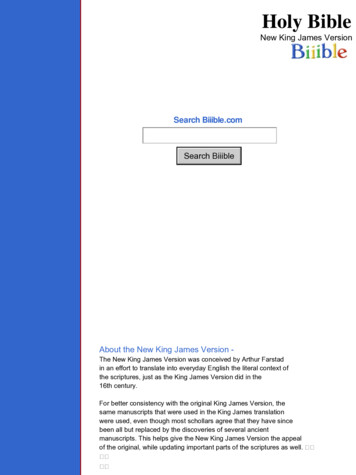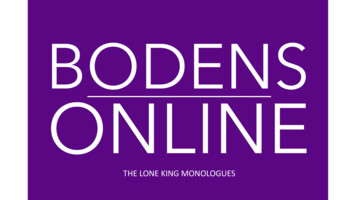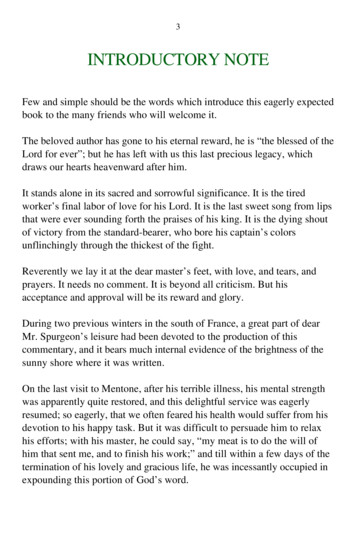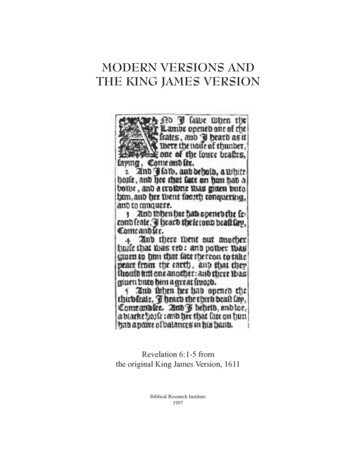
Transcription
Modern Versions and the KJV — Page 1MODERN VERSIONS ANDTHE KING JAMES VERSIONRevelation 6:1-5 fromthe original King James Version, 1611Biblical Research Institute1997
Modern Versions and the KJV — Page 2Modern Versions and the KJVBiblical Research InstituteMIntroductionany Seventh-day Adventist are aware of the ongoing debate in our church over which Bibleshould be read, the Kind James Version (KJV)or one of the modern versions. Much of thediscussion has originated with those who believe the KJV isthe only Bible that should be used by God’s remnant people.But most Adventists are not aware that the “KJV Only” controversy has been going on for over a century within variousProtestant churches and is still a point of heated debate.In some quarters the debate has degenerated intomean‑spirited, abusive, and insulting rhet oric which doesnot reflect the spirit of Christ. James R. White suggests thatDr. Peter Ruckman of the Pensacola Bible Institute is themost vocal and abusive defender of the KJV. White quotesRuckman as calling a gentleman who does not agree withhim a “deceived fool,” stupid, and “a miserable little liar”whose ideas are nothing but his own “conceited opinions.”1In his Bible Believer’s Commentary on Acts 19:2, Ruckmansays, “If you can’t handle verse 6 as it is written, what isthe point in changing verse 2, unless you are trying to play god’ for a bunch of idol‑worshipping suckers ( Christians’)who are too stupid to check their speedometers?”2 Althoughother defenders of the KJV are not as abusive as Ruckman,his insulting rhetoric does little to commend his cause to aserious thinker.Seventh‑day Adventists who prefer the KJV must notallow themselves to be dragged down to Ruckman’s level.In our discussion of Bible versions, a petty, mean spirit willnot win the day for anyone and it will certainly misrepresentChrist. The strong feeling and clear statements on the part ofKJV Only defenders that modern versions minimize and glossover distinctive Adventist teachings and that the use of modern versions will lead to a falling away from the three angels’messages, must not turn us from a calm, cool‑headed approachto the issues that raise this controversy in our church.Most defenders of the KJV, both within and outsidethe Adventist faith, see some kind of conspiracy behind thereadings in modern versions that differ from the KJV. AmongAdventists the Jesuits and the Roman Catholic Church seem12345to be the conspirators.3 Outside our church the New Age (aunion of Eastern mysticism and the occult) conspiracy is apopular candidate.4 When the Greek text of the Textus Receptus is compared with the “New Greek” found in the Nestle’sand the United Bible Society’s editions of the Greek NT, thedefenders of the KJV propose a conspiracy on the part ofapostate church fathers in early Christianity.5A meeting of the minds between those who stand for “TheKJV Only” and those who see no harm in reading a modernversion may be beyond ready possibility, especially if KJVdefenders continue to insist there is conspiracy behind everyother version. This study is a modest attempt to accomplishfour things: (1) a brief review of the issues invovled in thecontroversy, (2) a brief look at some variant readings that KJVOnly defenders cite as evidence of an existing conspiracy (fora more detailed treatment see James R. White, The King JamesOnly Controversy), (3) a short history of the development ofthe Textus Receptus and the KJV, and (4) Ellen White’s appraisal of the revised versions that appeared in her day.Definition of TermsThe following terms will be used throughout thisstudy:TR Textus Receptus, the edition of the Greek NewTestament that reflects the largest number of theNT Greek manuscripts (Byzantine texts) lyingbehind the KJV. In this study, references to theTR are based upon Stephanus’s third editionof the Greek NT published in 1550 and Beza’sfourth edition published in 1598.MS a single Greek manuscript.MSS two or more Greek manuscripts.Byzantine text the type of text found in the majorityof NT manuscripts.James R. White, The King James Only Controversy (Minneapolis: Bethany House Publishers, 1995), 110-11.Ibid., 240 (n.12).Russell R. Standish and Colin D. Standish, Modern Bible Translations, (Rapidan, Virginia: Hartland Publications, 1993).G.A. Riplinger, New Age Bible Versions (Munroe Falls, Ohio: AV Publications, 1993).Ibid., 338-39.
Modern Versions and the KJV — Page 3Alexandrian text the type of text that is found inmany of the oldest NT manuscripts, best represented by Codex Vaticanus (B, 4th century),Codex Sinaiticus (Aleph 4th century), and thepapyrus MS P75 (3rd century). This text‑typehas now become the accepted text among textualscholars and the basis for new Bible versions.Issues in the ControversyThe proverbial glass of water best illustrates the core ofthe controversy between the defenders of the TR and the Alexandrian text. Is the glass half full or half empty? Whateverthe answer, it is a matter of perspective. This, in turn, becomesthe core of the argument between those who defend the KJV,which is based on the Byzantine text‑type that underlies theTR, and the majority of new versions based on the Alexandriantext‑type.Those who defend the TR say that it contains the completeand accurate text of the Greek NT and is closest to what theauthors originally wrote.6 God has preserved this text throughthe centuries, they say, while the various “corrupt” types oftext ceased to be copied by scribes in the early centuries ofchurch history. The “corruption” of the Alexandrian text‑typecan be seen in its omission of words, phrases, and wholeverses, as well as its substitution of words and transpositionof words and phrases.The “corrupt” text of MSS Aleph and B originated withsuch church fathers as Origen and Eusebius and grew out ofthe Arian controversy of the third and fourth centuries—adebate that raged over the nature of Christ.7 Thus, some TRdefenders say that Aleph and B reflect a conspiracy to depriveJesus of His divinity. This, in turn, has laid the foundation forthe New Age concept that Jesus was only one of many christsthat have appeared through out history and the belief that allhumans have divinity within. This teaching of Eastern mysticism has its roots in the original deception, “And ye shall beas God” (Gen. 3:5, KJV, margin).Defenders of the Alexandrian text, on the other hand, saythat the TR is “corrupt” because it is a conflated text. That isto say, copyist scribes over the centuries have added words,phrases, and even whole verses from notes written in themargin of manuscripts and other sources out of fear of omitting something that the authors might have originally written.Because the MSS representing the Alexandrian text are theoldest, they best represent what the authors originally wrote.8Defenders of the Alexandrian text argue that the more often atext is copied, the more likely it will be corrupted. Becausethe Byzantine text lying behind the TR and the KJV has thelongest history of being copied, it is more likely to havebeen corrupted by additions. Bruce Metzger notes the factthat textual critics studying ancient non‑Christian religiousliterature are convinced that these texts tended to grow overthe centuries and that scribes did not deliberately omit portions of what they copied. What happened among copyistsin the history of the transmission of these ancient religiouswritings no doubt happened as Christian copyists reproducedthe NT text.9Those who defend the KJV argue that it reflects themajority of Greek MSS, therefore it is the most accuratetranslation of the “autographs” (original documents) intoEnglish. Those who defend modern versions note that theKJV follows readings in places where the TR itself does notcarry the majority Byzantine Greek text which the KJV Onlyadvocates defend so passionately. Therefore modern versionsare closer to what the original authors wrote. This brings usfull circle to the proverbial question, Is the glass half emptyor half full? The vexing problem is, we do not know. Not oneof the original documents produced by Bible writers has everbeen found.The fact that we do not have the autographs has createda problem that White identifies as “the desire for absolutecertainty.” White goes on to say, “It is argued that unless weembrace the KJV as our ‘final authority,’ we have no finalauthority at all, and hence all is subjectivity and uncertainty.People do not want subjectivity, but desire certainty and clarity, and so we must hold to the ‘traditional’ text.”10 But how dowe know that Erasmus, or Stephanus, or Beza, whose workslie behind the TR, chose the correct reading when the MSSof the majority text disagree with each other? The answer is,we don’t.But this does not mean that all is lost and we are swimming in a sea of uncertainty when we read our Bibles andtry to discern the Word of the Lord. Some have estimatedthat there are approximately 200,000 variant readings in the5,300 plus MSS and fragments of the Greek NT. It has alsobeen noted that only about one‑ eighth of the variants haveany significance. This means that over 98 percent of the textof the NT is pure whether a person reads the TR or anotheredition of the Greek NT.11At those places where significant variants occur, the rulesof textual analysis can be applied and tentative conclusionsreached; tentative, because only the autographs could resolvethe question as to which variant reading is the correct reading.6 Standish and Standish, 23.7 Riplinger, 334-50.8 Bruce M. Metzger, The Text of the New Testament: Its Transmission, Corruption, and Restoration (New York: Oxford University Press, 1968),133-34.9 Ibid., 163.10 White, 93.11 Ibid., 93.
Modern Versions and the KJV — Page 4Until they are found, if ever, an honest decision guided by theHoly Spirit and based upon the experience of working withancient MSS is the best we have.In the discussion over which Bible should be read, it isimportant to remember that usually the differences betweenmodern English versions and the KJV simply reflect differences between the Byzantine and Alexandrian text‑types.Many KJV Only defenders, however, present these differences as proof of conspiracy on the part of the editors of theEnglish versions when these editors are merely reflecting thedifferences that already exist in the different types of Greektexts.In fact, some KJV Only advocates see a conspiracy evenwhen a modern version gives a literal, word‑for‑word translation of the TR, but that translation differs from the KJV. Forexample, where the KJV reads “deliver us from evil” in theLord’s Prayer (Matt 6:13), the NEB and NIV read “deliver[save] us from the evil one.” The readings found in the NEBand NIV are condemned as corrupt when, in fact, they areactually literal translations of the TR. In addition, the KJVedition with chain references has the following note on Matt6:13, “Or the evil (one).” Examples such as the above makeit clear that for many KJV defenders the KJV has become thestandard of how the Bible should read even if it disagrees withthe TR that lies behind it.Such inconsistencies on the part of KJV Only defendershas led White to conclude:King James Onlyism is a human tradition.It has no basis in history. It has no foundation infact. It is internally inconsistent, utilizing circularreasoning at its core, and involves the use of moredouble standards than almost any system of thoughtI have ever encountered.12When a person has a fixation on conspiracies, he seesevidence of them at every turn. If there is no evidence, itis created. Riplinger’s work, New Age Bible Versions, is agood example. Anyone who has read this book will noticethe repeated use of ellipses in her quotations, especially thosefrom the work of B. F. Westcott and F.J.A. Hort. Because shebelieves there is a New Age conspiracy behind the Greek textproduced by these men, she sets out to prove it. White ownsthe books written by Westcott and Hort that Riplinger quotes,and when he checked her quotations, he wrote, “I wassimply shocked by the blatant editing of the wordsof these two men by Gail Riplinger.”13121314151617On some pages, White could not find the words thatRiplinger is supposed to be quoting, and on others there isnothing “remotely relevant to the quotation.”14 White says,The fact that a number of pages cited by Riplinger in her note, in fact, contain nothing relevantto her excerpt, and the complete “cut and paste”nature of her citation, makes it difficult to identifythe specific pages from which she is allegedlydrawing her information.15In bewilderment, White asks:Is it possible, to be fair, that Riplinger is simplynot familiar enough with the subject to follow sucha complex work as this by Westcott and Hort? Andhow would we know? If a pattern of this kind of“cut and paste” citation is found, we can safelyconclude that New Age Bible Versions presents anunfair and unreliable view of modern scholarship.Does such a pattern exist? An impartial review ofthe work proves that such a pattern does indeedexist.16Controversial PassagesSpace limitation makes it impossible for us to examinein depth all readings in modern versions that are criticizedby KJV Only advocates. Only a sample from those that theygive the greatest attention will be examined. For a moredetailed presentation, The King James Only Controversy isa good source. We must emphasize once more that most ofthe differences between the KJV and modern versions reflectdifferent readings in the two Greek text‑types behind them.One of the most frequent criticisms of modern versionsis the supposed omission of terms connected with the divinity of Jesus. Many times charts like the following attempt toillustrate the point.17 By examining the two columns, “omissions” found in modern versions can clearly be seen as wellas alternate readings.ReferenceKJVModern VersionsMatthew 4:18Matthew 12:25Mark 2:15Mark 10:52Luke 24:36JesusJesusJesusJesusJesusHeHeHeHeHeIbid., 249. White repeatedly points out examples of this double standard as he examines the position of KJV Only advocates.Ibid., 100.Ibid., 101.Ibid., 101.Ibid., 102.Chart adapted from The King James Only Controversy, 45-46, 194-95.
Modern Versions and the KJV — Page 5Acts 19:101 Corinthians 16:22Acts 19:41 Corinthians 9:12 Corinthians 4:10Hebrews 3:11 John 1:7Revelation 1:9Revelation 12:171 Thessalonians 3:112 Corinthians 5:18Acts 15:11Acts 16:311 Corinthians 5:42 Corinthians 11:312 Thessalonians 1:82 Thessalonians 1:122 John 1:3Lord JesusLord Jesus ChristChrist JesusJesus ChristLord JesusChrist JesusJesus ChristJesus ChristJesus Christour Lord Jesus ChristJesus ChristLord Jesus ChristLord Jesus ChristLord Jesus ChristLord Jesus ChristLord Jesus ChristLord Jesus Christthe Lord Jesus esus our LordChristLord JesusLord JesusLord JesusLord JesusLord JesusLord JesusJesus ChristTwo observations are important regarding the differencesappearing in the above chart. First, in the first five passagesthe KJV reads Jesus while modern versions read He. The“substitution” of He for the name Jesus is supposed to bean example of attempts to minimize the deity of Jesus. Butif you read the Gospels as they appear in the KJV, you willdiscover that He was considered to be a perfectly good word,used repeatedly in reference to Jesus. The personal pronounHe is “substituted” for Jesus to minimize repetition. Pronounswere invented for this purpose. Where it is used, the contextalways will let you know who the He is.Mark 2:15 from the above chart is one of several versesthat Riplinger lists in her chart that supposedly proves modernversions are “preparing mankind to receive the Antichrist and‘worship the dragon.’”18 But when you look at the versessurrounding Mark 2:15 in the KJV, you will see He is usedever ywhere to refer to Jesus. If the use of He instead of Jesusin Mark 2:15 minimizes the deity of Jesus and prepares theworld to receive the antichrist, then what is to be made ofall the other uses of He in reference to Jesus in the KJV? Isthere a conspiracy here as Riplinger wants all of her readersto believe?Among the first five passages in the chart above, Mark2:15 provides a good illustration, because the TR actuallyreads He and not Jesus. Modern versions have been severelycriticized for downgrading Jesus by replacing His name withHe when the truth is modern versions give a literal translationof the TR where the KJV does not. This leads us to the secondobservation based on what is found in the above chart.The rest of the chart illustrates a common characteristicof the Byzantine text‑type: names and titles for Jesus havebeen expanded. For example, pious scribes expanded Jesusinto Jesus Christ, the Lord Jesus into the Lord Jesus Christ,etc. The older Alexandrian MSS do not show this “expansion1819202122of piety,” as White calls it.19 Again, is the glass half emptyor half full, and how does one know the Byzantine text wasexpanded by pious scribes and the text was not shortened byAlexandrian scribes? Mark 2:15 helps us again by showingthat “expansion of piety” exists. Where the TR reads He,the KJV committee piously expanded the reading to Jesus.A careful comparison between the TR and the KJV would,no doubt, show other differences in other passages that arecriticized by KJV Only defenders. We have already examinedtwo in this paper, Matthew 6:13 and Mark 2:15.John 6:47 is another verse held up by KJV Only advocatesas an example of minimizing the divinity of Jesus in modernversions,20 but it is really another example of expansion ofpiety. The KJV reads, “Verily, verily, I say unto you, He thatbelieveth on me hath everlasting life.” Almost all modernversions leave out “on me,” thus simply saying that all whobelieve have everlasting life.Gar Baybrook’s comment on this verse is restrainedcompared with those of D. A. Waite. Baybrook says, “ OnMe’ has been left out. Belief alone is not sufficient. The devilbelieves. We must believe on Jesus implicitly.”21 Waite, on theother hand, labels the apparent omission of “on me” “one ofthe CLEAREST theological errors.” It presents “ANOTHERGOSPEL” because a person is free to believe in anything hechooses and have everlasting life—”in Santa Claus, in theEaster Bunny, in the Tooth Fairy, in Rudolph the Red‑nosedReindeer. . . . This is SERIOUS THEOLOGICAL PERVERSION! This is certainly a matter of doctrine andtheology”22In fact, is the “omission” of “on me” in John 6:47 partof a conspiracy on the part of the editors of modern versionsto minimize the divinity of Jesus? If you consult a modernversion, you will find something very similar to the followingquotes from the NASB:Jesus said to them, “I am the bread of life; hewho comes to Me shall not hunger, and he whobelieves in Me shall never thirst (John 6:35).For this is the will of My Father, that everyone who beholds the Son and believes in Him, mayhave eternal life; and I Myself will raise him up onthe last day (John 6:40).If a conspiracy exists to minimize the divinity of Jesus byomitting believing “on me” in John 6:47, why did the moderneditors not remove belief in Jesus from verses 35 and 40 ofthe same chapter? And why were the following verses in theNASB not edited by this conspiracy?Riplinger, 17.White, 196.See White, 170-73.Gar Baybrook, The S.D.A. Bible (Payson, Arizona: Leaves of Autumn Books, 1990), 78.D.A. Waite, Defending the King James Bible (Collingswood, New Jersey: The Bible For Today, 1992), 158.
Modern Versions and the KJV — Page 6He who believes in Me, as the Scripture said,“From his innermost being shall flow rivers of living water” (John 7:38).Jesus said to her, “I am the resurrection, andthe life; he who believes in Me shall live even if hedies, and everyone who lives and believes in Meshall never die. Do you believe this?” (John 11:25,26).And Jesus cried out and said, “He who believesin Me does not believe in Me, but in Him who sentMe” (John 12:44).I have come as light into the world, that everyone who believes in Me may not remain in darkness(John 12:46).We noted earlier that White sees the KJV Only defendersas using a double standard. Believing on Jesus is an excellent illustration of this. While Baybrook and Waite criticizemodern versions for leaving “on me” out of John 6:47, leavingpeople to wonder what they are to believe or who they are tobelieve in, they make no mention of the following verses inthe KJV that do exactly what they accuse modern versions ofdoing. Can you see a conspiracy in the following verses fromthe KJV?Jesus said unto him, If thou canst believe,all thing are possible to him that believeth (Mark9:23).For I am not ashamed of the gospel of Christ:for it is the power of God unto salvation to everyone that believeth; to the Jew first, and also to theGreek (Romans 1:16).For Christ is the end of the law for righteousness to every one that believeth (Romans 10:4).But to the rest speak I, not the Lord: If anybrother hath a wife that believeth not, and she bepleased to dwell with him let him not put her away(1 Corinthians 7:12).Believe what, or in whom? The KJV does not say. Is thisa conspiracy? Of course not. How, then, can the “omission”of “on me” in John 6:47 be a part of a conspiracy when statements all around this verse say that those who believe in Jesuswill have life?How can the “omission” in John 6:47 be explained? Itis another example of copyists’ expansion of piety. Since intwo verses (6:35, 40) just prior to John 6:47 read, “he whobelieves in Me” and “believes in Him,” it would be very easyfor a pious scribe to bring verse 47 into harmony with verses35 and 40. And if the scribe was well acquainted with theGospel of John, he would probably remember that there areother verses that read “believes in Me.” What we see here isharmonization based on expansion of piety.Riplinger sees a conspiracy on the part of modern versionsto lead Christians into the errors of the New Age movementand finally the acceptance of antichrist. Among the manyevidences cited for such a conspiracy is the use of the word“age(s)” by modern versions instead of “world.” She says:The real religion of America is astrology, ifthe study of Northern Illinois University is correct, indicating that 70% of Americans read theirhoroscope. The children are following, as Gallop’s[sic.] pole [sic.] showed 60% of them also believedin astrology. If ‘ages’ are standard in the religion oftoday’s internationals and Americans, be assuredthat the New International Version, New AmericanStandard and the New King James are attuned tothe religion of the age. So dozens of times theysubstitute “ages” for “world”, reinforcing the ideasof the “New” age movement.23The KJV is fairly consistent in translating the Greekword aion (age) as “world” except where it is used for vastexpanses of time, i.e., “for ever,” or “for ever and ever.”A leading authority in Greek, Joseph Henry Thayer, gives“age” as the primary meaning of aion. Aion was thought ofby ancient Greeks as defining a container in which things arecontained, “i.e., the aggregate of things contained in time.”24Therefore “world” is a permissible translation of aion becauseit is contained within time.Modern versions are not wrong in translating aion as”age” nor is there a conspiracy behind such a translation. Theysimply make a distinction between aion and two other Greekwords for world—kosmos, something that is orderly, i.e.,“world” or “universe,” and oikoumene, “inhabited earth.”Space does not permit further investigation of variouspassages that come under criticism by KJV Only defenders.The reader is directed to White’s book, The King James OnlyControversy, for further examples.The charge that modern versions minimize the deity ofJesus re‑echoes throughout the writings of KJV Only defenders. However, there are a number of places where modernversions are stronger and clearer on the deity of Jesus than23 Riplinger, 282-83.24 Joseph Henry Thayer, Thayer’s Greek-English Lexicon of the New Testament (Grand Rapids: Associated Publishers and s Authors, Inc.,n.d.).
Modern Versions and the KJV — Page 7the KJV. One example is John 1:18. The KJV reads, “No manhath seen God at any time; the only begotten Son, which isin the bosom of the Father, he hath declared him.” Modernversions like the NASB read, “only begotten God,” and theNIV, “but God the One and Only” instead of “only begottenSon.”The phrase, “only begotten Son,” appears in John 3:16,18 where the theological context is the gift of God’s Son tothe fallen human race. The theological context of the openingto John’s gospel, of which 1:18 is the summary, is the deityof Jesus, and “only begotten God” fits this context better than“only begotten Son.” Without a doubt, the modern versionsmake a stronger statement about Jesus’ deity than the KJV,especially the NIV where Jesus is called God.It appears that some KJV advocates criticize “only begotten God” because they do not understand what the phrase“only begotten” conveys. For example, one critic of modernversions says, “How can anyone claim that one that is begotten is at the same time essential God, equal in every respectto God the Father, and to God the Holy Spirit? This makesChrist to be a created Being”25 This writer is thinking of “onlybegotten” in terms of origin. What is not understood is that“only begotten” conveys the idea of uniqueness or priority.This concept is clearly illustrated in Hebrews 11:17 whereIsaac is called Abraham’s “only begotten son.” Actually Isaacwas not Abraham’s only begotten son for he had several sons,one of whom was Ishmael. But Isaac had priority. He had thebirthright, and the covenant promises passed from Abrahamthrough him to Jacob, thus he was the “only begotten son.”Because “only begotten Son” is used to describe Jesus’relationship with the human race in John 3:16, 18, it is easy tosee how a scribe could have harmonized John 1:18 with Hisunique position as Son. In the introduction to John’s gospel,Jesus is proclaimed as God, as the Creator, and in summarizing his introductory comments in 1:18, John proclaims Jesus’priority, His uniqueness, His divinity— “the only begottenGod.”In some passages, modern versions make a clearer statement about the divinity of Jesus than the KJV. This is especially true in Titus 2:13 and 2 Peter 1:1 where they adhere toGranville Sharp’s rule. Sharp’s rule, simply stated is, Whentwo common, singular nouns in the same case are connectedby “kai” (and) and there is an article in front of the first nounonly, both nouns refer to the same person or thing.Compare Titus 2:13 in the KJV and the RSV:Looking for the blessed hope, and the gloriousappearing of the great God and our Saviour JesusChrist (KJV).25 Jay P. Green, Sr. in The King James Only Controversy, 258.Awaiting our blessed hope, the appearing ofthe glory of our great God and Savior Jesus Christ(RSV).The wording of the KJV presents two Gods: (1) “the greatGod” and (2) “our Saviour Jesus Christ.” The RSV presentsonly one, “our great God and Savior Jesus Christ.” The RSVis following Sharp’s rule of Greek grammar and thus rendersa clearer statement on the deity of Jesus.This difference can be seen again in 2 Peter 1:1:Simon Peter, a servant and an apostle of JesusChrist, to them that have obtained like preciousfaith with us through the righteousness of God andour Saviour Jesus Christ (KJV).Simon Peter, a servant and apostle of JesusChrist, To those who have obtained a faith of equalstanding with ours in the righteousness of our Godand Savior Jesus Christ (RSV).The RSV is clear that Jesus is both God and Saviour,while this important truth is obscured in the KJV. Is therethen a conspiracy on the part of the men who produced theKJV to minimize the divinity of Jesus? No. We have lookedat only three examples where modern versions are clearer onJesus’ deity than the KJV. There are others as well.Two Problem PassagesTwo lengthy passages present textual problems that areidentified in various ways in modern versions. One is theclosing verses of Mark (16:9‑20) and the other is the story ofthe woman taken in adultery (John 7:53‑8:11).There is a division of opinion among NT scholars asto how Mark ended his gospel. Five different endings aresuggested by various MSS sources. The uncertainty over theending is reflected in modern versions. The NIV has a boldblack line after Mark 16:8 with a note, “The two most reliable early manuscripts do not have Mark 16:9‑20.” The RSVseparates verse 8 from verse 9 by a double space and has thefollowing note at the bottom of the page:Some of the most ancient authorities bring thebook to a close at the end of verse 8. One authorityconcludes the book by adding after verse 8 the following: But they reported briefly to Peter and thosewith him all that they had been told. And after this,
Modern Versions and the KJV — Page 8Jesus himself sent out by means of them, from eastto west, the sacred and imperishable proclamationof eternal salvation. Other authorities include thepreceding passage and continue with verses 9‑20.In most authorities verse 9‑20 follow immediatelyafter verse 8; a few authorities insert additionalmaterial after verse 14.Because the supposedly “corrupt” MSS Aleph (Sinaiticus) and B (Vaticanus) are the primary “ancient authorities”that omit verses 9‑20, KJV Only defenders are critical ofmodern versions that either follow the Alexandrian text‑typeor indicate in a note that textual problems exist. Riplingersees the omission in Aleph and B as part of a conspiracy toremove the teaching of Jesus’ ascension.26 The Standish brothers say the omission resulted from carelessness in copyingand is further evidence that these two MSS are faulty.27 It isobvious that when there are so many possible readings for agiven passage that something is wrong. But because we donot have the autograph of Mark’s Gospel, we do not knowwhich ending is correct, or if any of them are correct.Metzger suggests three possibilities for the confusion:(a) the evangel
THE KING JAMES VERSION Revelation 6:1-5 from the original King James Version, 1611 Biblical Research Institute 1997. Mo d e r n Ve r soi n s a n d t h e KJV — Pa g e 2 In some quarters the debate has degenerated into . of the original documents produced by Bible writers has ever been found.
